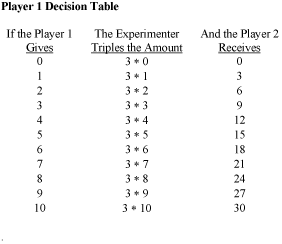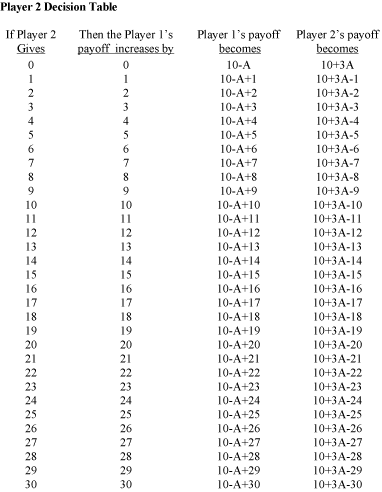|
|
|
The investment game is a sequential game with salient fairness considerations. In its structure it incorporates many motives of behavior present in everyday life, such as altruistic or inequality-averse other-regarding preferences and trust in positive reciprocity.
The investment game was first introduced to the literature by Berg, Dickhaut, and McCabe (1995). It is designed to study trust and reciprocity behavior in an investment setting. Trusting behavior in the investment game scenario allows players to achieve outcomes that are Pareto superior to the Nash prediction for the self-regarding preferences model.
|
|
The investment game is played by two players, both endowed with $10. The game has two stages. In stage 1 the first mover decides how much money to pass to an anonymous second mover. All money passed is increased by a multiplicative factor greater than 1, for example 3. In stage 2 the second mover then decides how much to return to the first mover.
|
- There are 2 players participating in the two-stage game: player 1 and player 2.
- At the beginning both players are endowed with $10.
- Stage 1: player 1 decides whether to pass some of his money to player 2 or not (let's call this amount A, where A
 0). 0).
- Maximum amount that can be passed is the whole endowment of $10.
- Any amount passed is tripled by the experimenter; any amount taken is not transformed.
- Stage 2: before making his/her move player 2 knows the outcome of the stage 1.
- Player 2 can now give some money back to player 1.
- Each dollar given by player 2 to player 1 costs player 2 one dollar.
|

|

|
|
The unique subgame perfect Nash prediction for the self-regarding preferences model with perfect information is to pass zero money, since a self-interested person would return nothing in the final stage. It can be solved for by using the backward induction method. This subgame perfect Nash equilibrium is Pareto-inferior to some alternative feasible allocations when player 1 passes a positive amount of money to player 2 which increases the stake to be divided between them. First movers are commonly observed passing money to second movers. Thus, explanations of this behavior have incorporated alternative motives for behavior, including trust, reciprocity, and fairness.
|
|
It has been often observed that players 1 identify the possibility of creating a surplus by sending positive amounts to paired players 2 and use trust for mutual gain. For example, in the Berg, Dickhaut, and McCabe (1995) experiment 55 out of 60 players 1 send at least some money. These amounts were then tripled by the experimenters and thus resulted in higher total payoffs to the players. Furthermore, many players 2 returned various amounts of money to players 1.
|
|
The first mover gives a positive amount of money because he trusts that the second mover will return some of the money.
The first mover gives a positive amount of money because he has altruistic other-regarding preferences.
The second mover returns some money because of positive reciprocity.
The second mover returns some money because she has altruistic or perhaps inequality-averse other-regarding preferences.
|
|
To test for quantitative effects of altruistic or inequality-averse other-regarding preferences, trust in positive reciprocity, and positive reciprocity itself, one can use a triadic design incorporating dictator controls. For the descriptions of Investment Game Dictator Controls see the Dictator Game section.
|
|
A first mover gives the maximum amount of money, i.e. $10, to the second mover; thus the allocation after stage 1 is ($0, $40). The second mover can decide to reciprocate the behavior and give part or all $40 to the first mover; let this amount be x. Thus the first and second movers are left with an allocation ($x, $40-x) after stage 2. If x>= $10 then the final allocation is Pareto superior to the endowments ($10,$10).
|
|
Trust game software at Vecon Lab
For a classroom experiment see also A Simple Investment Game Experiment for the Classroom by Ananish Choudhuri.
|
|
J. Berg, J. Dickhaut, and K. McCabe, "Trust, Reciprocity, and Social History." Games and Economic Behavior, July 1995, 10¹, pp. 122-42.
Cox, James C., "How to Identify Trust and Reciprocity," Games and Economic Behavior, 46, 2004, pp. 260-281.
|
| |